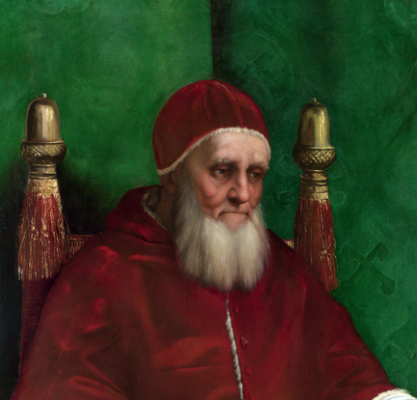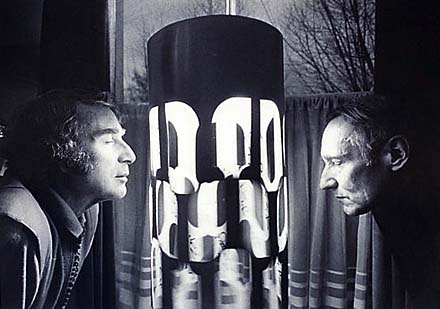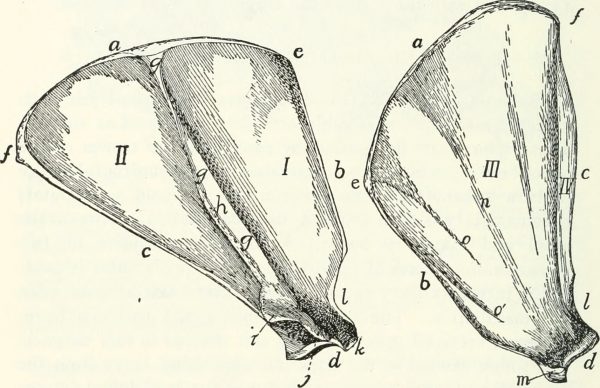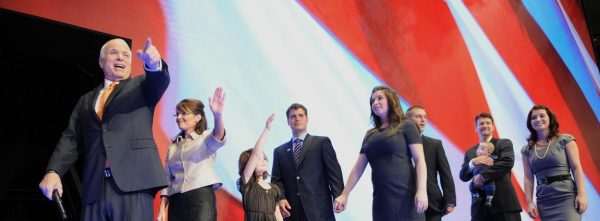Five is a number dense with theological significance. Five are the books of the Torah, five the wounds of Jesus, five the pillars of Islam and the elements of the universe according to Aristotle. The Pythagoreans called the star with five corners, the Pentagram, ‘health’, and used it as a secret sign by which to identify themselves. On the fifth day God created the creatures of the sky and of the oceanic abysses and ‘He saw that it was good.’ Multiply five by one hundred, the secular number par excellence, and you get 500. February 1513, February 2013: five centuries that close upon themselves.
In the last days of February 1513 – halfway through the 500 years of the Little Ice Age – an old, feverish man was meeting his end in a Vatican palace. It is recounted that as he lay on his deathbed a fierce wind blew through the streets of Rome. He was Julius II, the ‘Pope dressed in armour’, the warrior Pontifex who had spent his life fighting to ‘push back the barbarians’ – that is, the French superpower – and to create an independent Italian kingdom. Having succeeded the weak Pius III, who ruled for only three weeks before being poisoned by his own attendants, Julius II was well aware of the perils of his position.
He would go down in history as one of the most intrepid figures of the Italian Renaissance, a visionary politician and patron of the arts as well as a supremely corrupted Pope, quick to anger and plagued with syphilis. He showed little interest in theology, but he understood his job better than most of his predecessors or successors: he knew that the Vatican seat was an imperial throne, and dared to act accordingly. Having started his career as a Franciscan, the order most devoted to poverty, he had no ideological difficulty in seeing through the religious pretensions of the Church to its essential nature as an instrument of power: the steel blade that cuts through the fabric of history rather than the fiery sword of Uriel that defends the Garden of Eden.
In the last days of February 2013 – at the beginning of the new age of Global Warming – another old man, plagued by scandals and paralysed by guilt, was committing an almost unprecedented act: stepping down from the Papacy. Like Pius III, Benedictus XVI had been dethroned by those closest to him. The Church he was leaving behind resembled him: weak, aloof, sinking into historical irrelevance. Only another Pope dressed in armour could save it. So it was that, as if through a miraculous metempsychosis, the spirit of Julius II seemed to descend again into the Vatican City. The new Pope named himself Franciscus after the poorest of saints, yet, like his other Franciscan soulmate, he understood the operations of power. He even had one advantage over his bellicose precursor: he was a Jesuit, and one of the finest. Part propagandist and part diplomat, part actor and part playwright, Franciscus knew how to turn talks on Love into formidable political weapons, and how to use public displays of humility as tools for high diplomacy. Where Julius II had failed, overcome by the growing pressure of an ever-more-northern Northern Europe, Franciscus was in a position to once again ‘push back the barbarians’. His adversaries, however, were no longer the limited army of a French king, but the uncountable, insidious legion of financialised global capitalism.
Franciscus began his pontificate in the midst of a world in crisis. Over a century of hyper-technological nihilism had destroyed humanist culture; the so-called financial crisis had crushed even the comfortable middle classes of the Western world, while turning the transnational upper class into a despotic oligarchy; widespread fear and xenophobia had taken the place of social solidarity. In all this, the radicalisation of religious allegiances across the world seemed to have caught the Catholic Church in a bind, its fading spiritual capital further depleted by endless scandals and its insistent bigotry on issues of civil rights. The millenary foundations of the Church were crumbling. Not only had its physical places of cult become little more than empty museums, but its traditional political allies were in decline. Christian Democrats and Conservatives no longer exercised complete control over the modern Western state, with the very form of the state and the role of political parties under challenge. The Church was in need of fresh partners and a comprehensive rebrand, and it didn’t have much time. Great was the confusion under the Heavens, and the situation was excellent – for a political strategist who was shrewd.
Even in this great confusion, one thing was clear: beyond the purely religious dimension, the roots of the crisis in the Church stretched into political grounds, and required a political resolution. When its purpose is the achievement of power, politics has very little to do with one’s personal convictions. To consider Franciscus’ public, political manoeuvrings is not to investigate the authenticity of his privately-held beliefs. We should concentrate instead on the mark left by his actions and on the trajectory traced by his policy.
Franciscus’ political strategy has two parts: on the one hand the establishment of a new network of alliances, with the associated rebranding, and on the other a comprehensive internal restructuring of the institution he leads. Actions belonging to one line of intervention can be used to influence the development of the other, a fact not lost on the Jesuit Pope. Franciscus combines the protean and theatrical qualities of his early brethren Matteo Ricci and Francis Xavier – the sixteenth-century Jesuits who established the first missions in China and Japan – with the ancient Taoist generals’ obsessive attention to organising their forces on the battlefield.
The Pope’s strategic decisions are based, therefore, on a careful reconnaissance of the global political and economic situation. As he looks to the state of the West, Franciscus cannot fail to notice how it appears to have decisively swapped its modern, progressively revolutionary ambitions for a new/old set of reactionary revolutionism. As the ultra-rich, global corporations and the financial system bend all levels of social institutions to serve their own interests, xenophobia, ultranationalism and repression appeal to an increasingly disenfranchised, disillusioned, impoverished majority. In the words of the Italian theorist Franco ‘Bifo’ Berardi, himself borrowing the vocabulary of Deleuze and Guattari, the unsettling ‘deterritorialisation’ – that is, the dislocation of reality – produced by decades of neoliberal, financial capitalism is pushing the masses of the West towards a rigid form of ‘reterritorialisation’ – or reclaiming of firm land – with ultra-right connotations.
The position once held by the European Left – that solidarity is to be valued above the homo homini lupus, and that the concept of freedom doesn’t merely have a negative character – has been abandoned. The attitude which Mark Fisher defines as ‘capitalist realism’ appears to have engulfed most of the mainstream Left. Although the recent successes of Syriza in Greece and Podemos in Spain seem timidly to hint at a possible revival of a radical Left, all the major democratic/labour parties in the West appear to converge towards a neoliberal and bleakly anti-humanist consensus. Only in Latin America does the Left still enjoy a comfortable hegemonic status, while also being able to present the future as a land of opportunities rather than a hostile wasteland. Although it is unlikely that Franciscus has read Berardi’s remarks on ‘the end of the future’ and on the consequences of its demise, he has grasped the immense political potential of reopening – and monopolising – the very concept of the time to come.
Consistently with these considerations, Franciscus has placed his pontificate under the bright red star of what was once considered a revolutionary Leftist worldview. In doing so he has been able at the same time to reinforce his presence in the Latin American countries – partly through a revival of the rhetoric and politics of Liberation Theology – and to present himself as the only credible candidate to occupy the gaping hole vacated on the left of the Western political spectrum. He has founded his attack on spectacularly populist tactics, made even more universally appealing by his repeated (yet slyly ambiguous) claim that many call him a Communist, but that he is no Communist – only a true Christian, faithful to the call of Love.
To secure the previously unthinkable possibility that the Church might emerge as a great power on the Left, Franciscus is sawing together a network of global political alliances within which the Church seeks to enjoy a hegemonic position. Barely a year into his pontificate, Franciscus has held a number of private meetings with Alexis Tsipras, Greek PM and leader of the radical-left party Syriza, in order to devise a common plan of action at the level of the European parliament(s). By joining forces with Tsipras, Franciscus gains access to that galaxy of radical Left parties – including Podemos in Spain and L’Altra Europa in Italy – that look to Tsipras for guidance. Franciscus’ Jesuit training shines through a strategy which owes a debt to the missionary activity of Matteo Ricci in China, where the Jesuit priest created a political network by ‘converting the prince in order to convert his people’. On the strength of this public alliance with Tsipras, Franciscus was able to set up the World Meeting of Popular Movements, held in the Vatican in October 2014. The meeting hosted a huge array of militant and extra-parliamentary movements – from the Brazilian Sem Terra to the Latin American indigenous movements, from the Italian anarcho-autonomists of the Centri Sociali to representatives of ultra-left trade unions – alongside more traditional social-Christian formations. This event, widely covered by the mainstream media, brings back images of the Alter-Mundialist movement of the late 1990s and early 2000s, and presents the Church as a force capable of restarting a truly internationalist emancipatory movement.
In the meantime, Franciscus has lost no time in organising countless publicity stunts during which he is seen displaying either his humility – by renouncing the luxurious paraphernalia of his role – or his proximity to the poor – as with his visits to prisons and migrant detention centres. His image reinforces his familiarity with those who are campaigning for ‘bread and dignity’, as when he concluded a mass with striking miners from Sardinia by urging them to ‘keep up the fight’. These exercises are in turn reinforced by his public, rhetorical assaults against those whom he perceives as his enemies; as when he attacks the ‘barbarism’ of European policies against migrants, the ‘abomination’ of the prison system and especially of life sentences, the ‘satanism’ of arms traders and manufacturers, the ‘inhumanity’ of capitalists and financiers who put ‘profits before people’ and governmental policies that foster inequality which he labelled as ‘state-sponsored terrorism’.
This complex web of interventions seeks to re-position the Church at the centre of several interrelated movements: Franciscus is at once a political peer to Alexis Tsipras; a hegemonic partner to the galaxy of radical movements who have no institutional political representation; and the only apparent hope for the poor and dispossessed. This strategy of interlocking alliances goes beyond the plain diplomacy of the warring states of Italian Renaissance – as deployed by Julius II – and resembles more closely that of an imperial power in a period of expansion.
In order to establish himself as an imperial actor, Franciscus needs first of all to secure control over his own empire. His programme of institutional reform within the Church, and his campaign to rebrand its public image, suggests that he is taking the necessary steps. His earliest structural interventions replicated those of Cardinal Mazarin and Louis XIV, purging the Vatican’s administrative offices of those members of the Fronde who had destroyed his predecessor and replacing them with a series of loyalists. Such an absolutist turn is intensified – rather than weakened – by Franciscus’ reforms to democratise the administrative workings of the Church. Through this process the Pope presents himself as a radical while weakening the Vatican ‘aristocracy’ and reinforcing his own position: indeed, all are equal below the king.
Such a combination of external populism and internal absolutism brings to mind the recent trajectory of the Latin American Left, specifically Hugo Chavez in Venezuela. Like Chavez, who died only a week before the Papal election, Franciscus promotes at the same time an unmediated and caring relationship between the masses and the monarch – Franciscus always asks the poor to ‘pray for me’ – and the establishment of a global anti-capitalist counter-power with himself at the helm. Yet, even more than Chavez, Franciscus aims to universalise his message: he addresses the poor and dispossessed as humans, rather than as members of a class, a religion, an identity or a nationality. He has spared no energy in stressing the openness of his new Church to all, including divorced people, homosexuals, transgender people and even atheists, and in presenting his institution as non-sectarian. In his interdenominational meetings with representatives of other religions, Franciscus modifies his language accordingly, to the point of virtually substituting any references to God with an inclusive discourse around Love. Franciscus’ brand of populist humanism is literally catholic, as from the Greek katholikos, ‘universal’, inasmuch as its references to Love encompass the universal category of the human, while excluding from its reach only those which he identifies as belonging to the host of Satan.
This remarkable blend of syncretic theology and manichean division between Love and Satan is the pinnacle of Franciscus’ political strategy. It synthesises and enhances the populism of his message, the ambition of his hegemonic politics, the modern public image of his reformed institution and, most importantly, the possibility of simplifying the realm of political action down to a division between ‘good-humans’ versus ‘evil-Satanic forces’. Through his alliances and through his rhetorical skill and political imagination, Franciscus is working to create a front which unites all the creatures of God – regardless of their class, gender, ethnicity, legal status, sexuality, or religious belief – against the forces of Satan. The reintroduction of Satan into political discourse has only superficial theological connotations and is not at odds with Franciscus’ otherwise modern policies, since its purpose is the creation of a nebulous enemy which is always, necessarily and irredeemably ‘evil’. And ‘evil’, according to the Church Father Saint Augustine, is a category which lacks any ontological status: an easy enemy to defeat, since it doesn’t even exist.
We can understand Franciscus’ determination to fortify the institution of the Catholic Church. The natural question arising at this point is: why should the secular, radical Left seek Franciscus as its ally? Why should the Left trust the leader of an institution with a long history of connivance with the bleakest reactionary forces and a track record of repressive violence? Once again, I invite the reader to consider this in purely strategic terms. The Left, like the Catholic Church, has been forced to reconsider its strategy by analysis of the current political situation. There is increased support among Western populations for xenophobic, repressive governmental policies against those who can least defend themselves, and the Western Left is no longer capable of reversing this turn to the Right. Mainstream ‘left-wing’ politicians seem keener to chase their right-wing counterparts than to produce their own new brand of emancipatory politics, and the electorate is growing ever more tired with the homogeneity of mainstream policy. Communist parties are no more, trade unions are in crisis, and bottom-up radical movements such as Occupy seem like awkward re-enactments of twentieth-century scripts. The Left needs new allies if it is to check our descent into abyssal inequality, global civil war, environmental catastrophe and the further expansion of the prison-industrial system.
Franciscus’ absolutist Vatican monarchy can be a precious ally to the struggling Western Left. Indeed, that the Catholic Church has kept many of the most reactionary regimes in history in power is proof of the great value of its political support. As an Italian, and as an atheist and left-wing anarch, I can hardly neglect the role played by the Catholic Church in maintaining the corrupt regime of the Democrazia Cristiana for over fifty years – yet, this only makes me wonder what we could do now, with the Church on our side.
The controlling role that Franciscus wants for his institution must trouble political movements that hold freedom and autonomy in the highest esteem. However, without the aid of a powerful, unifying and active force such as Franciscus’ Church it is unlikely that in the foreseeable future the Left will be able to avoid losing even more ground, reduced to the role of frightened spectator as the West descends into capitalist nihilism and the politics of tribalism. For too long the Left has privileged abstract speculations over practical, strategic considerations, and the time has come for an approach that achieves the goals of left-wing politics in practice rather than in theory.
Franciscus’ discourse around Love and Satan can prove useful to the currently semi-defunct emancipatory project. As the extreme Right rallies the disillusioned masses against migrants, benefits recipients, prisoners and the poor, the Left has succeeded only in creating the bogeyman ‘One Per Cent’, a force almost implicitly acknowledged as invincible. Alas, cowardice is perhaps the only essential aspect to our human nature, and it is yet to be seen in history that the prospect of assaulting an adversary which is perceived as superior – the One Per Cent – will be preferred by the majority over the option of attacking one than is perceived as inferior – the dispossessed. Conversely, Franciscus’ semi-manichean rhetoric of Love versus Satan creates exactly the right rhetorical and psychological effect. Rather than portraying financial capitalist, militarist nationalists and police forces as powerful adversaries, Franciscus presents them as less-than-human obscenities, vermin provoking disgust rather than fear and deserving annihilation. Franciscus’ rhetoric of militant, universal and struggling Love radically transforms the enemy into a ‘non-being’ – in line with Augustine’s understanding of evil as non-existence – and thus as the object of a just, guilt-free and winnable assault.
Reconstructed in these terms, xenophobic, repressive, financial and neoliberal forces cease even to be the targets of a concerted attack, transformed instead into unhygienic elements to be cleaned away. How could it be otherwise, if ‘we’ – the unemployed, the working poor, the prisoners, the illegal aliens, the single mothers – are the forces of Love? Necessarily our enemies must be the agents of Hatred and Destruction. No longer will leftists be forced into the awkward position of answering whether sinking migrant boats and privatising public healthcare is ‘good for the economy’ or ‘bad for the economy’: finally, they will be able to simply rail against the ‘abomination’, the ‘bestiality’, and ultimately the ‘Satanism’ of their opponents.
There is no doubt that this conceptual construction of the enemy as a sub- human monster has a long and appalling history. It is the rhetoric of the Crusades, of totalitarian regimes and, indeed, of recent right-wing politics such as those demonising ‘terrorists’, paedophiles and the ‘feral’ underclasses. To embrace it is dangerous. Yet we must acknowledge that this brand of populist discourse is extremely effective in the construction of a united front. Allying with Franciscus’ new Church, embracing its crusading rhetoric of Love and even accepting the likely hegemonic position of the Church in the network of left-wing forces, will enable just that: a strong, well- organised and financially powerful global network of radical-left forces capable of effectively unleashing the pent-up, reterritorialising violence of the masses and to redirect it against the barbaric, late-capitalist, nationalist ‘host of Satan’.
Franciscus’ war rhetoric sounds terrifying, and rightly so. If it is embraced by a transnational, united Left-wing front, it might be capable of destroying its enemies, placing the poor and dispossessed as close to a position of power as they have ever been. But it would be a mistake to assume a safe and consistent path that will lead from this revolutionary explosion to the creation of a stable and effective system of emancipatory politics in the following peacetime. It might be the case that, having harnessed the power of the Church to their own ends, the victorious Left will decide to overthrow their old, Catholic allies and to enforce a further, post-theological turn to the new political and administrative framework. That will be the hard path of reform and, as Alex Williams once remarked, ‘revolution is easy, reform is hard’. Yet, without a victorious revolution, the chance for reform might never arise.
On that portentous night of 1513, while on his deathbed, Julius II absolved his nephew Francesco Maria from all the thefts and murders he had perpetrated while fighting the ‘barbarians’. But Julius II wouldn’t have absolved him and his successors of their greatest sin, still to come: their inability to convert his military conquests into a stable political framework that was able to transcend the brutally contingent character of war. Reforms retroactively justify revolutions – it is yet to be seen if this will be the case with Franciscus, the Pope dressed in armour, and his allies.




